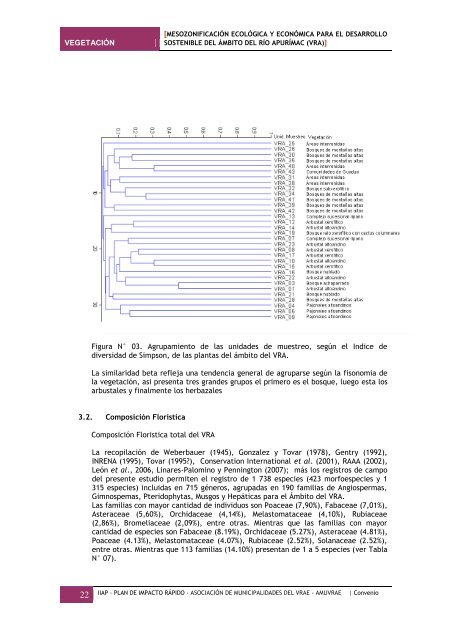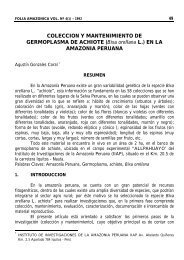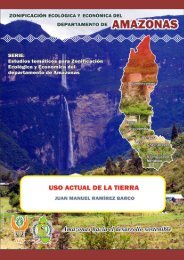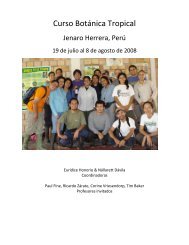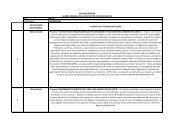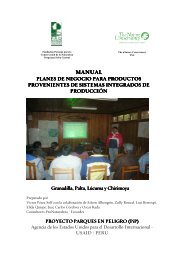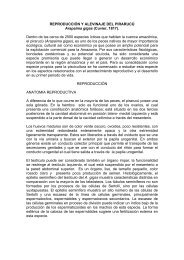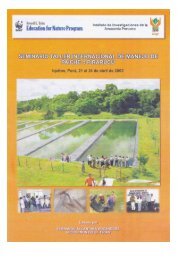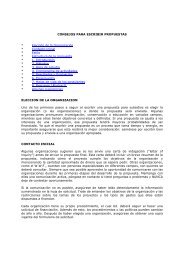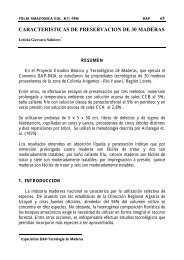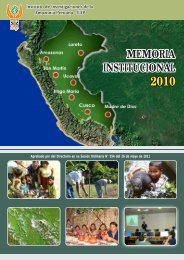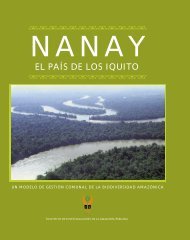Descargar - Instituto de Investigaciones de la Amazonía Peruana
Descargar - Instituto de Investigaciones de la Amazonía Peruana
Descargar - Instituto de Investigaciones de la Amazonía Peruana
Create successful ePaper yourself
Turn your PDF publications into a flip-book with our unique Google optimized e-Paper software.
VEGETACIÓN<br />
[MESOZONIFICACIÓN ECOLÓGICA Y ECONÓMICA PARA EL DESARROLLO<br />
SOSTENIBLE DEL ÁMBITO DEL RÍO APURÍMAC (VRA)]<br />
Figura N° 03. Agrupamiento <strong>de</strong> <strong>la</strong>s unida<strong>de</strong>s <strong>de</strong> muestreo, según el Indice <strong>de</strong><br />
diversidad <strong>de</strong> Simpson, <strong>de</strong> <strong>la</strong>s p<strong>la</strong>ntas <strong>de</strong>l ámbito <strong>de</strong>l VRA.<br />
La simi<strong>la</strong>ridad beta refleja una ten<strong>de</strong>ncia general <strong>de</strong> agruparse según <strong>la</strong> fisonomia <strong>de</strong><br />
<strong>la</strong> vegetación, asi presenta tres gran<strong>de</strong>s grupos el primero es el bosque, luego esta los<br />
arbustales y finalmente los herbazales<br />
3.2. Composición Florística<br />
Composición Floristica total <strong>de</strong>l VRA<br />
La recopi<strong>la</strong>ción <strong>de</strong> Weberbauer (1945), Gonzalez y Tovar (1978), Gentry (1992),<br />
INRENA (1995), Tovar (1995?), Conservation International et al. (2001), RAAA (2002),<br />
León et al., 2006, Linares-Palomino y Pennington (2007); más los registros <strong>de</strong> campo<br />
<strong>de</strong>l presente estudio permiten el registro <strong>de</strong> 1 738 especies (423 morfoespecies y 1<br />
315 especies) incluidas en 715 géneros, agrupadas en 190 familias <strong>de</strong> Angiospermas,<br />
Gimnospemas, Pteridophytas, Musgos y Hepáticas para el Ámbito <strong>de</strong>l VRA.<br />
Las familias con mayor cantidad <strong>de</strong> individuos son Poaceae (7,90%), Fabaceae (7,01%),<br />
Asteraceae (5,60%), Orchidaceae (4,14%), Me<strong>la</strong>stomataceae (4,10%), Rubiaceae<br />
(2,86%), Bromeliaceae (2,09%), entre otras. Mientras que <strong>la</strong>s familias con mayor<br />
cantidad <strong>de</strong> especies son Fabaceae (8.19%), Orchidaceae (5.27%), Asteraceae (4.81%),<br />
Poaceae (4.13%), Me<strong>la</strong>stomataceae (4.07%), Rubiaceae (2.52%), So<strong>la</strong>naceae (2.52%),<br />
entre otras. Mientras que 113 familias (14.10%) presentan <strong>de</strong> 1 a 5 especies (ver Tab<strong>la</strong><br />
N° 07).<br />
22 IIAP - PLAN DE IMPACTO RÁPIDO - ASOCIACIÓN DE MUNICIPALIDADES DEL VRAE - AMUVRAE | Convenio


